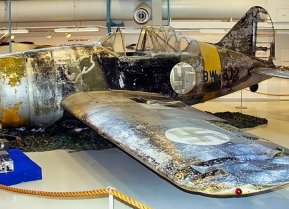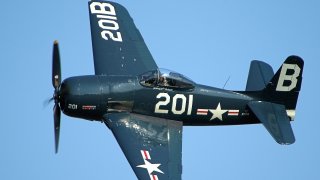Grumman F8F Bearcat: The US Navy's Speed Demon Fighter
Some have suggested that the Grumman F8F is little more than an engine with a saddle on it. That might be hard to argue against.
Meet the Grumman F8F Bearcat – An Air Racers Delight - As a contrast to the large Gruman F6F Hellcat, which has often been described as more pugnacious than elegant, the United States Navy also adopted the Grumman F8F Bearcat. The single-engine, carrier-based aircraft was introduced in the final year of the war, and it was the last, yet most powerful, of Grumman's prop-driven fighters.
Grumman F8F - Small But Capable
Grumman engineers, led by chief Engineer William Schwendler, sought to fill a major gap in the low and medium altitude ranges for U.S. Navy carrier-based fighters. The goal was to create a small fighter, similar to the Wildcat or Hellcat, but with much more speed, rate of climb, and maneuverability than any other carrier fighter in service or under development.
The result was a small but speedy aircraft.
In fact, some have suggested that the Grumman Bearcat is little more than an engine with a saddle on it, and by all accounts that isn't far from the truth. Its designers set out to design the smallest size airframe that would accommodate the R-2800 engine and specified fuel. At the time of its development, the philosophy behind the Bearcat ran in parallel with that which resulted in the XP-51F and H Mustangs.
The difference was that the Navy sought an entirely new aircraft. As a result, progress wasn't as speedy as the eventual fighter-bomber/night fighter to come. Prototypes were ordered on November 27, 1943 and it took Grumman ten months to get the aircraft off the ground in its maiden flight. However, the Navy liked what it saw and in October 1944 Grumman was awarded a contract to build 2,023 – while Eastern Aircraft also received an order to produce an additional 1,876 aircraft, which were designated the F3M-1.
Deliveries began on December 1, 1944 but as the war ended the following September, the order was scaled back to just 1,265.
Grumman F8F Bearcat Specs
The Bearcat was powered by a Pratt & Whitney R-2800-34W engine, rated at 2,400 hp for takeoff, while it had an emergency combat rating of 2,800 hp. The aircraft had a maximum speed of 455 mph (772 km/h, 395 kn) and a range of 1,105 miles (1,778 km, 960 nmi).
It was capable of mauling its prey, as it was armed with four 20mm (.79-inch) AN/M3 cannons, and could carry four 5-inch (127mm) HVAR unguided rockets as well as a 1,000 pound (454 kg) bomb load.
However, the Bearcat arrived too late to actually bear its claws during the Second World War, and it first saw combat while in the service of three Groupes de Chasse (fighter groups) of the French Armée de l'Air (Air Force) in French Indochina between 1950 and 1953.
Following France's defeat at the Battle of Dien Bien Phu in May 1954, twenty-eight surviving F8F Bearcats were transferred to the Republic of Vietnam Air Force and entered service in 1956. In addition, surplus U.S. military aircraft were supplied to Thailand.
Speed Racer – the Rare Bear
Due to their small size, Bearcats have proved popular in air racing, and one particular Grumman F8F Bearcat – the highly modified "Rare Bear" – dominated the Reno Air Races for decades. Packing up to 4,500 horsepower in a muscular 8,700-pound package, Rare Bear has won more Unlimited races than any airplane.
In addition, Rare Bear also holds the three-kilometer speed record 528.33 mphmaking it the fastest piston-powered, propeller-driven aircraft in the world
About the Author: Peter Suciu
Peter Suciu is a Michigan-based writer who has contributed to more than four dozen magazines, newspapers and websites. He regularly writes about military hardware, and is the author of several books on military headgear including A Gallery of Military Headdress, which is available on Amazon.com. Peter is also a Contributing Writer for Forbes.


